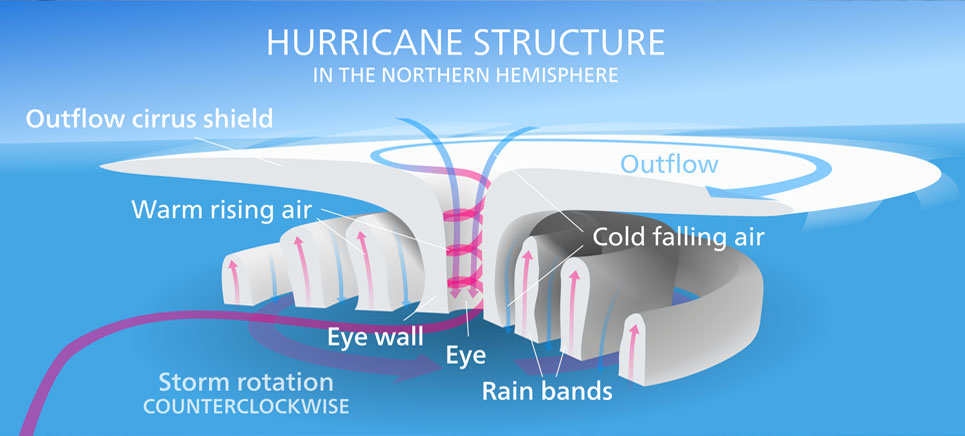The wind system is one of the strongest forces of nature that takes various forms such as storm, blizzard, typhoon, tornado, cyclone etc. Hurricanes are one such powerful force of nature that produce strong winds, storm surge, heavy rainfall, tornadoes and rip currents. They are also commonly called a tropical cyclone.
What is a Hurricane?
A hurricane is a weather system with very strong winds rotating around an area of low pressure which results in heavy rain and strong winds. Technically, the tropical storm can be classified as a hurricane only when the wind speed is over 63 knots (around 117 kmph). These are formed over warm ocean waters near the equator. Hurricanes are considered one of the most disastrous storms as they bring heavy rains, deadly waves and wild wind that causes million dollars damage to property and proves fatal for thousands of people.
Factors required for the formation of a Hurricane
- The temperature of the sea surface needs to be at least 26.5 degrees, to a depth of at least 50 m. This is important to make the overlying atmosphere unstable enough to sustain convection and thunderstorm.
- Rapid cooling with height as it will allow the release of heat that fuels the hurricane.
- High humidity in the lower to mid-troposphere. This humidity is required to feed the fierce storm.
- Low wind gradient to help the faster circulation of the wind.
How are the Hurricanes formed?
Hurricanes are typically formed between 5 and 15 degrees latitude north and south of the equator. They are formed over relatively warmer water. In addition to the warm ocean water, the region needs to have high degrees of humidity in the air.

The warm, moist air from the sea surface rises up creating an area of low air pressure. To fill the gap in the low-pressure area, air from the surroundings rushes in. Again the air gets heated and rises up rapidly and new air pushes in to take the place. The warm air rising up rapidly cools down to form clouds. The entire system of clouds and winds spins and grows, fueled by the heat and evaporated water from the sea surface. As this entire system rotates faster an area of low pressure is formed in the center called the eye of the storm. As the rotating speed of the storm crosses 63 knots it is called the Hurricane. This swirling storm system brings destruction when it hits the land. Although tropical cyclone starts getting weakened as they hit the land as they no longer are fueled by the heat and moisture from the sea.
Storms that are formed north of the equator rotate in a counterclockwise direction while the storm formed to the south of the equator rotates in a clockwise direction. This is caused due to the Coriolis Effect.
Hurricane Season
The hurricanes are formed in the Atlantic basin, which includes the Atlantic Ocean, Caribbean Sea, Gulf of Mexico, eastern North Pacific Ocean and less frequently central North Pacific Ocean. The Atlantic Hurricane season typically starts from June 1st and goes until November 30th. While the eastern pacific hurricane season runs from May 15th to November 30th.
Why and How are Hurricanes Named?
Tropical storms such as cyclones, typhoons and hurricanes last long so they are given names so that scientists can keep track. Earlier the year was used to denote such storms but it created confusion as 100 different storms can occur in 12 months. Giving a short distinctive name to big storms make it easier to streamline communication about them.
The North Atlantic storms are named by the US National Hurricane Centre (NHS). There are six lists of names and are being used since 1979. The lists are arranged in alphabetical order and alternate between a male and a female name (Before 1979 only female names were used). The lists are recycled after every six years but the name used once for a big and destructive storm is retired and not used again. The lists contain names beginning from every English alphabet except for Q, U, X, Y and Z. If all the names have been used then the storms are named after Greek alphabets. The first storm of each year gets a name starting from the alphabet A.
Use the citation below to add this article to your bibliography
"Hurricane: Definition, Formation, Season and Nomenclature." Dashamlav.com. Web. 22 May 2025. <https://dashamlav.com/hurricane-definition-formation-season-nomenclature/>
Dashamlav.com, "Hurricane: Definition, Formation, Season and Nomenclature." Accessed 22 May 2025. https://dashamlav.com/hurricane-definition-formation-season-nomenclature/
"Hurricane: Definition, Formation, Season and Nomenclature." (n.d.). Dashamlav.com. Retrieved 22 May 2025 from https://dashamlav.com/hurricane-definition-formation-season-nomenclature/
